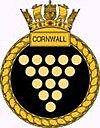 HMS Cornwall in the Persian Gulf
| |
| History | |
|---|---|
| Name | HMS Cornwall |
| Operator | Royal Navy |
| Builder | Yarrow Shipbuilders |
| Laid down | 14 December 1983 |
| Launched | 14 October 1985 |
| Sponsored by | Diana, Princess of Wales |
| Commissioned | 23 April 1988 |
| Decommissioned | 30 June 2011[1] |
| Homeport | HMNB Devonport, Plymouth |
| Identification |
|
| Motto |
|
| Nickname(s) |
|
| Fate | Scrapped October 2013 |
| Badge |  |
| General characteristics | |
| Class and type | Type 22 frigate |
| Displacement | 5,300 tons |
| Length | 148.1 m (485 ft 11 in) |
| Beam | 14.8 m (48 ft 7 in) |
| Draught | 6.4 m (21 ft 0 in) |
| Propulsion |
|
| Speed |
|
| Complement | 250 (max. 301) |
| Sensors and processing systems |
|
| Armament |
|
| Aircraft carried | |
HMS Cornwall was a Batch 3 Type 22 frigate of the Royal Navy. She was the first Batch 3 to be built, and the last to decommissioned. Cornwall was based at HMNB Devonport in Devon, England, part of the Devonport Flotilla.
She was built by Yarrow Shipbuilders and launched by Diana, Princess of Wales at Scotstoun on the River Clyde in October 1985 and commissioned at Falmouth in 1988 by the ship's sponsor, Diana, Princess of Wales (who was also the Duchess of Cornwall).
- ^ a b "HMS Cornwall F99". Helis.com. Retrieved 30 August 2021.
- ^ "Royal Navy Bridge Card, February 2009" (PDF). Retrieved 20 June 2009.
- ^ a b c d e f g "Royal Navy Major Surface Vessels". Archived from the original on 5 June 2011. Retrieved 27 February 2010.